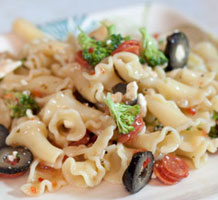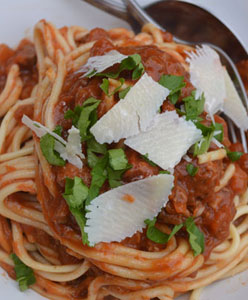Pasta Recipes

You might think that any old pasta works for any old dish. And it’s true that you can mix and match however you see fit. However, some pasta shapes definitely work better with different recipes and sauces. The right combination can create a perfect dish.
When choosing pasta, take a look at the density of the pasta. Thick pastas can handle heavier sauces. Additionally, the surface area of the pasta makes a huge difference. If you want the sauce to cling to the pasta so you get a lot of sauce in each bite, try wider pasta shapes.
Think about it this way; would you ever make macaroni and cheese with spaghetti? The answer is no, right? Because pasta shape matters.
Pasta Recipes
Let’s take a look at the most common pasta shapes and how they’re typically paired and why.
#1 Spaghetti, Buccatini, Cappelli, and Angel Hair Pasta
Spaghetti is a long thin noodle. It’s perfect for heavier meat sauces because the pasta can hold up under the weight of the sauce. Angel hair is ideal for thin tomato sauces or even a pesto. Add a meat sauce to angel hair and you’ll have a plate full of crushed and mushy noodles.
If you really want a sauce that will hold up to a thick meat sauce, try buccatini. It’s a thick spaghetti like noodle with a hole in the middle – like a long thin straw. Cappelli is a thin, spaghetti-like noodle. It’s ideal for broth based sauces.
 #2 Linguini and Fettuccini
#2 Linguini and Fettuccini
Both linguini and fettuccini are flat, thin pasta noodles. However, linguini is narrower than fettuccini. If you want more surface area, which means more sauce on your noodle, linguine and fettuccini are ideal. Linguini is typically served with seafood. It’s the perfect amount of pasta to not overwhelm the delicate taste of many types of seafood.
Fettuccini, on the other hand, is a thick ribbon of pasta. In fact it means “little ribbons” in Italian. It’s very hearty and perfect for dishes with heavy cream sauces.
#3 Orecchiette, Radiatore, Fusilli, and Farfalle
These pastas are not long and thin. Instead, they’re shapes. For example, Farfalle look like bow ties and Fusilli are thick spirals. These pasta shapes are ideal for hot and cold pasta salads. They soak up dressings and provide a nice bite size piece. Some people enjoy fusilli in cold salads while farfalle and radiatore may work better for hot salads. Farfalle is actually wonderful with cream based sauces and dressings. Orecchiette is a small circle shaped pasta and is better with drier sauces.
Finally, let’s take a look at some of the popular tube shaped pastas like rigatoni and penne. Both shapes are ideal for baked dishes. Penne is a bit thinner than rigatoni, which can stand up to hearty thick pasta sauces.
| Pattern Categories Browse the categories to help you find the patterns you're looking for. |
||







